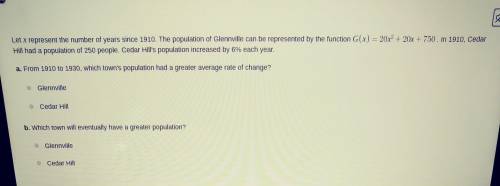Part A. From 1910 to 1930, which towns population had a greater average rate of change?
A...

Mathematics, 25.05.2020 09:58, Mtross30
Part A. From 1910 to 1930, which towns population had a greater average rate of change?
A. Gennville
B. Cedar Hill
Part B. Which town will eventually have a greater population?
A. Glennville
B. Cedar Hill


Answers: 3
Other questions on the subject: Mathematics

Mathematics, 21.06.2019 14:30, bossninja97588
Multiply −2x(6x^4−7x^2+x−5) express the answer in standard form. enter your answer in the box.
Answers: 3



Mathematics, 21.06.2019 23:30, johnlumpkin5183
Determine if the following statement is true or false. the normal curve is symmetric about its​ mean, mu. choose the best answer below. a. the statement is false. the normal curve is not symmetric about its​ mean, because the mean is the balancing point of the graph of the distribution. the median is the point where​ 50% of the area under the distribution is to the left and​ 50% to the right.​ therefore, the normal curve could only be symmetric about its​ median, not about its mean. b. the statement is true. the normal curve is a symmetric distribution with one​ peak, which means the​ mean, median, and mode are all equal.​ therefore, the normal curve is symmetric about the​ mean, mu. c. the statement is false. the mean is the balancing point for the graph of a​ distribution, and​ therefore, it is impossible for any distribution to be symmetric about the mean. d. the statement is true. the mean is the balancing point for the graph of a​ distribution, and​ therefore, all distributions are symmetric about the mean.
Answers: 2
Do you know the correct answer?
Questions in other subjects:





Mathematics, 02.11.2020 16:30

Chemistry, 02.11.2020 16:30


English, 02.11.2020 16:30

Mathematics, 02.11.2020 16:30

Mathematics, 02.11.2020 16:30






